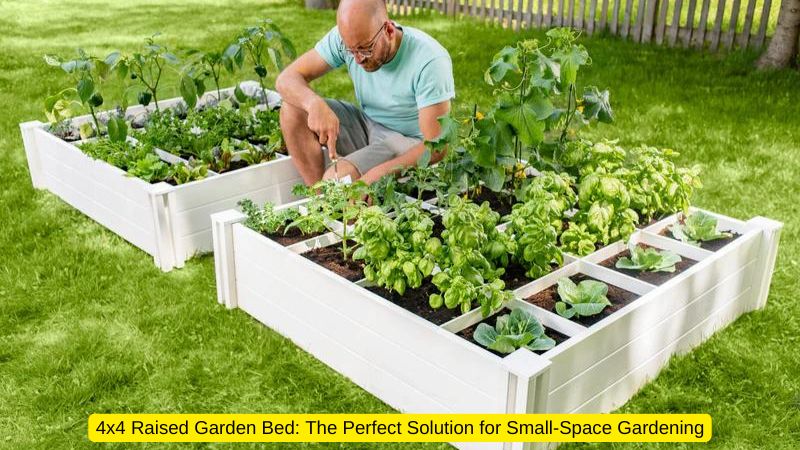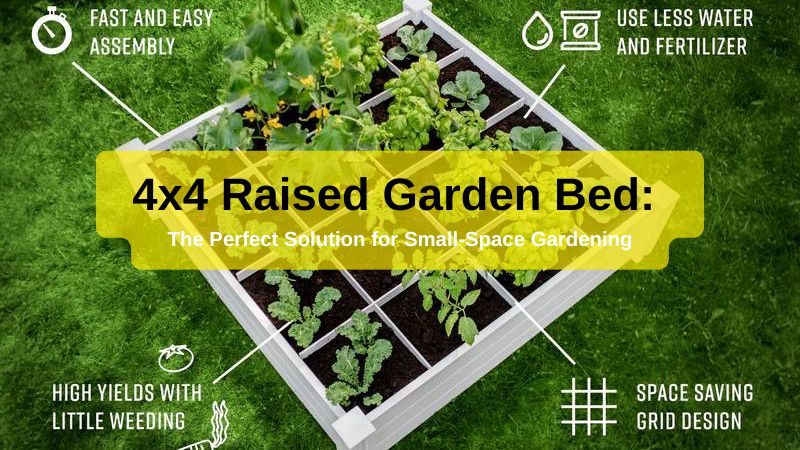A 4×4 raised garden bed is a versatile, space-efficient, and productive way to grow a variety of plants, herbs, vegetables, and flowers in your backyard, patio, or urban garden. This compact size provides an ideal growing space for both novice and experienced gardeners, while offering numerous benefits such as better soil control, easier maintenance, and improved plant health. In this article, Garden 03 will explore the advantages of using a 4×4 raised garden bed, how to build one, what to plant, and tips for ensuring your garden thrives.
Why Choose a 4×4 Raised Garden Bed?
Raised garden beds, in general, are a popular choice for many gardeners, and the 4×4 raised garden bed offers several unique benefits, particularly for those with limited space. Let’s look at why this size is perfect for both beginners and experienced gardeners alike.
1. Space Efficiency
The compact size of a 4×4 raised garden bed makes it an excellent choice for small yards, patios, or even apartment balconies. With 16 square feet of growing space, it provides ample room to grow a variety of crops without taking up too much space. This makes it ideal for urban gardeners, small families, or anyone looking to maximize their planting potential in a limited area.
2. Easier Maintenance
A 4×4 raised garden bed is easier to maintain than a larger garden plot. The manageable size allows gardeners to easily reach all areas of the bed without stepping on the soil, reducing the risk of compaction. It also makes tasks like watering, weeding, and harvesting more convenient, as everything is within arm’s reach. For those with limited mobility or back problems, the raised design also reduces the need to bend over.
3. Better Soil Quality and Control
With a raised garden bed, you have full control over the quality of the soil. This is especially important if the ground soil in your area is poor, compacted, or contaminated. By filling the bed with nutrient-rich soil, compost, and other organic matter, you can create the perfect growing environment for your plants. This leads to healthier, more productive crops, and reduces the need for chemical fertilizers.
4. Improved Drainage
One of the key advantages of using a raised garden bed is the improved drainage it offers. Since the soil is elevated above ground level, excess water can easily drain away, preventing issues like root rot and waterlogged soil. This is especially beneficial for areas with heavy rainfall or poor-draining clay soils.
5. Extended Growing Season
Raised garden beds warm up faster in the spring and retain heat longer in the fall, allowing you to extend your growing season. This means you can plant earlier and harvest later, getting the most out of your gardening efforts.
6. Pest Control
A raised garden bed can help minimize pest problems by keeping certain ground-dwelling insects and animals, like slugs and rabbits, away from your plants. You can also install mesh covers or protective barriers to further deter pests, ensuring your crops remain safe.
How to Build a 4×4 Raised Garden Bed

Building a 4×4 raised garden bed is a straightforward project that can be completed in a few hours, even by beginners. Here’s a step-by-step guide to constructing your own raised bed.
Materials You’ll Need:
- 4 wooden boards (2×6 inches, 4 feet long each) – untreated cedar or redwood are good choices for their durability and natural resistance to rot.
- 4 corner posts (2×2 inches, 12 inches long each).
- Galvanized screws or nails.
- A drill or hammer.
- A level.
- Landscape fabric (optional, for weed control).
- Soil, compost, and organic matter.
Step 1: Choose a Location
Select a sunny spot in your yard or garden, as most vegetables and flowers require at least 6-8 hours of sunlight per day. Make sure the area is level and has good air circulation. If you’re building the raised bed on grass, you may want to lay down landscape fabric or cardboard to suppress weeds.
Step 2: Assemble the Frame
Using your wooden boards and corner posts, start by assembling the frame of the raised bed. Attach the boards to the corner posts using galvanized screws or nails. Make sure the boards are level and flush at the corners. You’ll now have a sturdy 4×4-foot frame.
Step 3: Prepare the Ground
Once the frame is assembled, place it in your chosen location. If you’re building directly on soil, loosen the ground with a garden fork or tiller to improve drainage and encourage root growth. If you’re building on a hard surface, ensure that your bed has proper drainage by adding a layer of gravel or stones at the bottom.
Step 4: Add Soil and Compost
Fill the raised bed with a mixture of high-quality garden soil, compost, and organic matter. A good ratio is 60% soil, 30% compost, and 10% organic material like peat moss or coconut coir. This blend will provide essential nutrients, improve soil structure, and retain moisture, giving your plants the best chance to thrive.
Step 5: Plant Your Garden
Once your bed is filled with soil, you’re ready to start planting! Whether you’re growing vegetables, herbs, flowers, or a combination, plan your layout carefully to maximize space and ensure each plant has enough room to grow.
What to Plant in a 4×4 Raised Garden Bed
The compact nature of a 4×4 raised garden bed means that you need to be strategic about what and how you plant. With proper planning, you can maximize your harvest and grow a diverse range of crops. Here are some popular choices for small-space gardening:
1. Vegetables
A raised bed is perfect for growing vegetables, especially if you use intensive planting techniques like square foot gardening. Here are some suggestions for vegetable crops that thrive in a 4×4 raised garden bed:
- Tomatoes: Plant one or two tomato plants in the back of the bed, using stakes or cages to support their growth.
- Lettuce: Lettuce is a great crop for raised beds, as it grows quickly and can be planted in succession for continuous harvest.
- Carrots and Radishes: These root vegetables do well in the loose soil of a raised bed and can be planted in the same area for staggered harvesting.
- Peppers: Peppers are compact plants that fit nicely into a 4×4 bed. You can plant several varieties for a colorful and productive garden.
- Cucumbers: Train cucumber vines to grow vertically on a trellis at the edge of the bed to save space.
2. Herbs
Herbs are ideal for raised garden beds, as they require little space and thrive in well-drained soil. Popular herbs for raised beds include:
- Basil
- Thyme
- Cilantro
- Parsley
- Oregano
You can plant a variety of herbs together in one section of your bed, making it easy to create a small kitchen garden.
3. Flowers
Incorporating flowers into your 4×4 raised garden bed not only adds beauty but can also attract pollinators and beneficial insects to your garden. Consider planting:
- Marigolds: Known for their pest-repelling properties.
- Zinnias: Bright, colorful blooms that attract butterflies.
- Nasturtiums: Edible flowers that add both beauty and functionality to your garden.
4. Companion Planting
Companion planting is a smart way to maximize your 4×4 raised garden bed’s productivity. Certain plants grow better together and can help improve soil health, deter pests, and enhance flavor. For example:
- Tomatoes and Basil: Basil is said to improve the flavor of tomatoes and repel harmful insects.
- Carrots and Onions: Onions can help deter carrot flies, while the two crops won’t compete for nutrients.
- Peppers and Marigolds: Marigolds can keep pests away from your pepper plants.
Tips for Maintaining Your 4×4 Raised Garden Bed
Now that your 4×4 raised garden bed is planted, it’s essential to care for it properly to ensure your plants thrive. Here are some maintenance tips to keep in mind:
1. Watering
Because raised garden beds drain better than in-ground gardens, they may require more frequent watering, especially in hot, dry weather. Water your plants at the base to avoid wetting the leaves, which can lead to disease. Early morning or late afternoon is the best time to water to reduce evaporation.
2. Mulching
Adding a layer of mulch around your plants helps retain moisture, suppress weeds, and regulate soil temperature. Organic mulches like straw, shredded leaves, or grass clippings work well and break down over time, adding nutrients to the soil.
3. Fertilizing
Your plants will need a steady supply of nutrients to thrive. Use a balanced, organic fertilizer every few weeks to replenish the soil. Compost and worm castings can also be added to the bed as a natural source of nutrients.
4. Weeding
While a raised bed naturally reduces the number of weeds compared to in-ground gardening, some weeds may still pop up. Regularly remove any weeds by hand before they have a chance to take over.
5. Pest Control
Keep an eye on your garden for pests, such as aphids, slugs, or caterpillars. You can use natural pest control methods like neem oil, diatomaceous earth, or introduce beneficial insects like ladybugs to help control harmful pests. Additionally, companion planting (as mentioned earlier) can naturally deter pests from attacking your crops.
6. Pruning and Thinning
For plants like tomatoes, cucumbers, and peppers, regular pruning is essential to maintain airflow and promote healthy growth. Pinch off any dead or yellowing leaves, and remove side shoots (especially for indeterminate tomato varieties). Thinning is also important for root vegetables like carrots and radishes, ensuring they have enough space to grow properly.
7. Rotate Crops
To keep your 4×4 raised garden bed healthy and productive year after year, practice crop rotation. Rotating crops prevents the depletion of specific nutrients in the soil and reduces the risk of plant diseases and pests. For example, follow a planting cycle where you alternate heavy feeders like tomatoes with legumes like peas or beans, which help fix nitrogen in the soil.
8. Seasonal Care
At the end of each growing season, remove any dead plant material and add a fresh layer of compost or organic matter to replenish the soil. This will prepare your raised bed for the next growing season, ensuring it remains fertile and ready for planting.
Extending the Growing Season in a 4×4 Raised Garden Bed
One of the greatest advantages of a 4×4 raised garden bed is the ability to extend your growing season. By implementing a few simple techniques, you can enjoy fresh produce well into the fall and even winter months.
1. Cold Frames
A cold frame is a simple structure made of wood or plastic with a clear lid that traps heat and protects your plants from cold weather. You can build a cold frame to fit over your 4×4 raised bed, allowing you to grow cool-season crops like spinach, lettuce, and kale during the fall and winter months.
2. Row Covers
Row covers are lightweight fabrics that can be draped over your plants to provide protection from frost, wind, and pests. They are an easy and inexpensive way to extend the growing season for frost-sensitive crops like tomatoes and peppers.
3. Hoop Houses
A hoop house is a larger structure that covers the entire raised bed, acting as a mini greenhouse. You can construct one using PVC pipes and plastic sheeting, which will trap heat and protect your plants from cold temperatures, allowing you to grow a wider variety of crops year-round.
Conclusion
A 4×4 raised garden bed is a perfect solution for gardeners with limited space who want to grow their own vegetables, herbs, and flowers. Its compact size, ease of maintenance, and ability to provide full control over soil quality make it an ideal choice for both novice and experienced gardeners. By selecting the right plants, following proper planting techniques, and maintaining your garden throughout the growing season, you can enjoy a bountiful harvest from your 4×4 raised garden bed.
Whether you’re growing fresh produce for your family or cultivating a beautiful flower garden, this small but mighty gardening solution can yield impressive results. Plus, the flexibility of raised beds allows you to experiment with different planting layouts, companion planting, and creative designs to suit your gardening style. So, grab your tools, pick out your favorite plants, and get started on your very own 4×4 raised garden bed—a rewarding and productive way to embrace small-space gardening!





